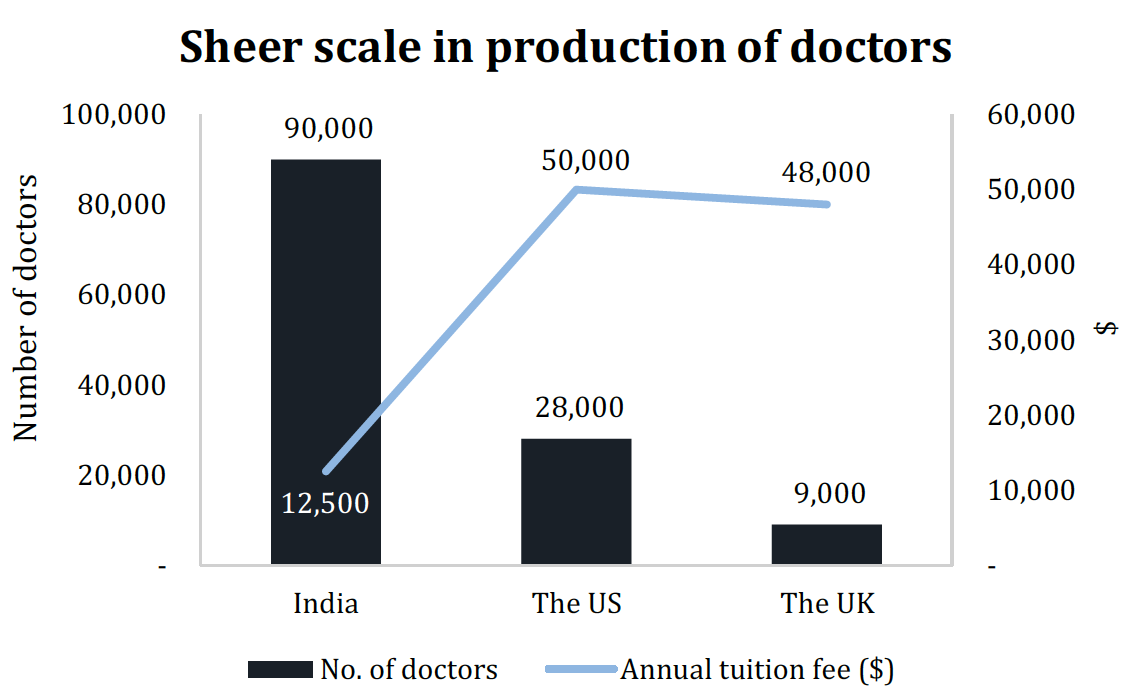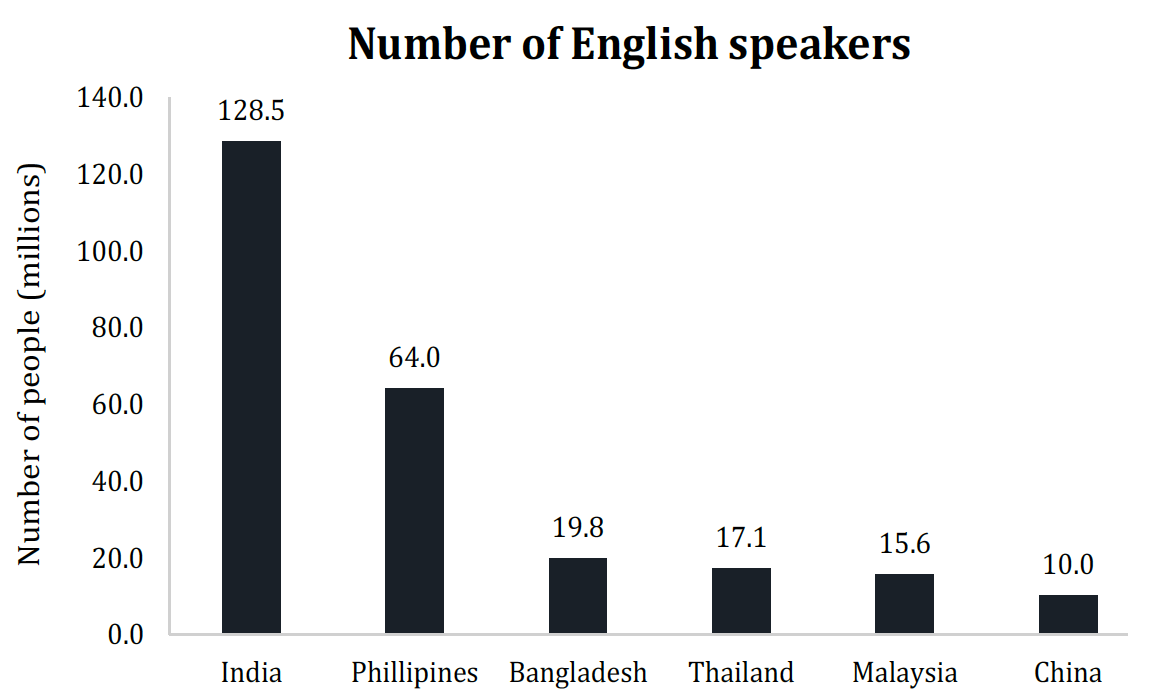August 2023
In physics, diffusion is a process by which particles move from regions of higher concentration to less concentrated areas. It is a fundamental principle that helps establish equilibrium in many systems. From the human respiratory system to the coffee we drink, diffusion results in the equilibrium that enables life and lifestyles.
Diffusion (or dispersion) can also be used to explain the causes of migration – a movement of people from regions of high population density (such as India) to areas of lower density (the US, Germany, Japan, etc.) that provide avenues for better lives and livelihoods. With developed nations experiencing aging populations and reduced fertility, the "low concentration" of skilled workers in these countries will be inexorably met by skilled workers from regions with a "high concentration" of such talent.
India, because of its vast availability of skilled labor and the cultural conditioning of its population, is expected to form an increasingly disproportionate percentage of the global workforce (40% by 2040). This is likely to increase developed nations' dependence on Indians, providing the country with political and diplomatic leverage.
The great Indian diaspora
India's migration story goes back centuries and straddles continents – from Africa to the Americas, including Europe, Australia, and numerous parts of Asia. Based on cultural factors (notably a hunger to succeed and an emphasis on education), Indians have contributed meaningfully to the local economies where they have migrated. In the US, almost 80% of the Indian population over school age holds undergraduate degrees or higher, compared with just 30% of the overall population. Therefore, it is hardly a surprise that the median household income of Indians as an ethnic group is now $123,700, ~75% more than the US national average of $70,784.
Of the 281 million migrants scattered across the globe today, around 32 million are of Indian origin, a number that many believe is understated. In recent years, an incremental ~2.5 million Indians have been emigrating annually, representing a powerful force in the countries they enter. Indians are usually not the poorest segment but relatively affluent, skilled, and well-educated who are flying to new lands out of choice and for opportunity. Today, ~70% of H1-B visa holders in the US are issued to Indian software engineers, while Indians account for ~30% of immigration visas issued by the United Kingdom (the highest of any country). As populations in the developed world age and stagnate, these nations have become reliant on India to plug their workforce shortages.
These Indian migrants, in turn, support consumption back home by remitting billions in savings. In 2022 alone, Indians abroad remitted $100 billion (~3% of India's GDP), a figure twice as much as all foreign direct investments that year (~$50 billion). In one example, people from the southern state of Kerala comprise 70% of the Indians in Kuwait and ~25% of the richest Indians in the entire Middle East. Their remittances sustain the economy of a state
as famous for its high literacy rate as its alcohol consumption – one wonders where the remittances get spent!
The production of skilled labor
India's high number of medical graduates positions it to meet the growing demand for medical labor and, by extension, shoring up healthcare systems pressured by declining fertility rates and aging populations. India produces thrice as many doctors as the US (and 10x the UK) at just 25% of the cost.

The manufacturing analogy explains the high efficiency of doctor production – India enjoys significant economies of scale across the entire "production chain" of labor – supply, manufacturing, and distribution. Every year, ~2 million students ("the supply chain") apply for 85,000 medical seats in India across 700 colleges. In contrast, the USA graduates only 28,000 doctors per year from
200 colleges while the UK graduates only 8,000 doctors per year from 44 colleges, reflecting the subscale "manufacturing" of these highly skilled workers.
India's trained labor gets distributed across domestic employment as well as "exports", i.e., skilled labor migrating abroad. Across both measures, India has shown a significant scale, with the "stock" of domestically skilled workers and exports having grown significantly. The stock of doctors in India increased from 827,000 in 2010 to ~1.3 million in 2020 (4.2% growth p.a.), whereas this number has dwindled precipitously in many developed countries.
The scale of the resultant labor "imports" has resulted in some nations becoming highly dependent on Indians for sustenance. In the UAE, Indians (~30% of the population) are vital to the medical, retail, and banking industries, to name a few. The small local population (~10% or 1 million citizens) rarely enter such mundane fields, preferring more luxurious pursuits such as Formula 1 and equestrian jumping where they have excelled in recent years.
National security risks as a consequence of migrant workers
Aging populations have also caused shortages in the numbers available to serve in sensitive industries such as the national military. Since the Russia-Ukraine war, several European countries have been mulling/enacting conscription laws. The Netherlands currently has a shortage of 9,000 soldiers that it plans to address through compulsory military service, while Latvia plans to reintroduce compulsory military service in 2024.
The resurgence of conscription (or any other sensitive roles reserved for locals) means these countries will experience even greater labor shortages for non-sensitive activities, thereby resulting in even greater dependence on skilled migrants from exporting nations like India. This dynamic may well exacerbate the wealth imbalance in favor of migrants who would continue to dominate non-sensitive but economically more lucrative industries.
Embodying the growth mindset
Culturally, Indians have always been inclined towards excelling in academics and learning English to advance in their careers (a mentality that Carol Dweck, the famous American psychologist, refers to as the "growth mindset"). Alas, this overemphasis on academics does have consequences on deemphasized areas such as sports. Hence, it is unsurprising that while the country outranks developed nations in producing doctors or engineers, it only wins a minuscule fraction of the medals at major sporting events.

India's history of British rule and focus on English has paid rich dividends for its skilled workers. Billboards advertising English-speaking classes dot the landscape across India. Upward mobility associated with English is seen as a massive step up from old social orders (where professions were inherited). One study estimates that fluency in English increases hourly wages by around 30%. Improving financial and social status motivates India’s workforce to learn the global lingua franca.
Road to Indian labor equilibrium
Despite proposed anti-immigration measures by politicians in various parts of the world, the reality is quite different. Large numbers of countries are embracing Indians not just to plug worker shortages but due to an increased dependence on them to sustain their economies.
The Netherlands is expected to face a shortage of ~1.3 million workers (~16% of the total population) by 2025. To counter this, the country has encouraged the migration of skilled workers through various policies. Indians migrating to the country increased by ~140% between 2012 to 2019 to 185,000, most joining the IT sector. Romania is another country leveraging India’s population base: 18,000 work permits (~20% of the total) are issued
annually to Indians, a significant increase from the past. Both these EU countries (and others) are practicing “selective migration” to fill the voids in their skills imbalances.
Increased Indian presence in countries around the world also contributes to increasing India's political clout. In May 2023, India and Israel inked an agreement to allow 42,000 Indians to work in Israel in the construction and nursing industries. Immigration through such channels and increased dependence on Indians will provide India with leverage to advance its diplomatic interests – a perfect political bargaining chip!
Paul Davies, the English physicist, had once remarked that diffusion is nature's way of balancing the books. The same appears to be the case for migration. Once referred to as a "brain drain" and a national tragedy, the volume of skilled talent being produced in the country has possibly resulted in the scales being tilted in India's favor. Necessity never made a good bargain, after all!